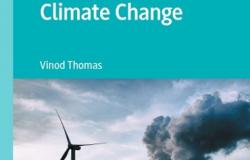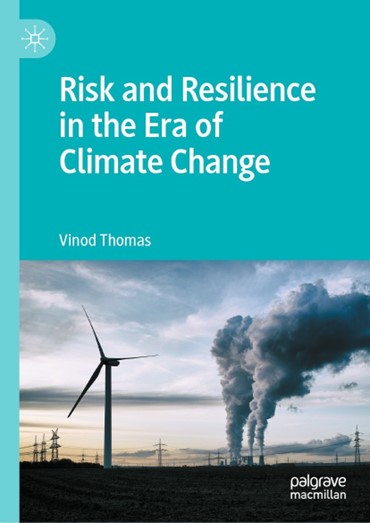Book Review - Risk and Resilience in the Era of Climate Change

Risk and Resilience in the Era of Climate Change by Vinod Thomas. Singapore: Palgrave Macmillan 2023. 232 pp., £24.99 hardcover 978-981-19-8620-8, £24.99 paperback 978-981-19-8623-9, £19.99 e-book 978-981-19-8621-5
Climate change, once a distant specter, has swiftly transformed into an immediate and intensifying crisis, characterized by a surge in natural calamities like scorching heatwaves, devastating floods, prolonged droughts, and ferocious tropical cyclones, all compounded by rising sea levels. This alarming trend disproportionately impacts developing nations, magnifying the vulnerability of marginalized communities. Shockingly, the frequency of these disasters has doubled since the late 20th century, predominantly propelled by weather-related phenomena, resulting in expanded destruction, heightened socioeconomic setbacks, and affecting a growing number of individuals.
This concerning escalation in disasters is intricately linked to unsustainable development practices, encompassing reckless environmental decisions, unbridled population expansion, rapid and unplanned urban sprawl, widespread poverty, and myopic economic policies. Vulnerable communities find themselves ensnared in a relentless cycle where disasters exacerbate existing vulnerabilities. Climate change further compounds these challenges by amplifying the frequency and intensity of hazards, introducing unpredictability that disrupts traditional livelihood patterns reliant on natural resources.
 In his captivating new book, "Risk and Resilience in the Era of Climate Change," Vinod Thomas makes a compelling argument for adopting a comprehensive strategy to enhance climate resilience. Central to his thesis is the recognition of interconnected risks that go beyond climate-related challenges, encompassing pandemics and geopolitical instabilities. Thomas emphasizes the need to move beyond mere adaptation, advocating for proactive measures to foster greater resilience in confronting emerging threats.
In his captivating new book, "Risk and Resilience in the Era of Climate Change," Vinod Thomas makes a compelling argument for adopting a comprehensive strategy to enhance climate resilience. Central to his thesis is the recognition of interconnected risks that go beyond climate-related challenges, encompassing pandemics and geopolitical instabilities. Thomas emphasizes the need to move beyond mere adaptation, advocating for proactive measures to foster greater resilience in confronting emerging threats.
The book follows a structured approach, divided into several key sections. "Troubled Times" initiates the discussion by addressing contemporary challenges and the need for resilience. "Understanding Risk" provides a comprehensive overview of global risk landscapes and disaster sources, while "Resilience That Shapes Risk" delves into resilience phases and priorities. Transitioning to the core focus on climate change, "New Highs in Risk and Resilience" underscores escalating risks. "The Climate Catastrophe" section scrutinizes the complexity of climate change, highlighting failures in addressing it effectively. "Integrating Resilience in Policymaking" offers practical solutions, emphasizing crisis management and transformative changes in policymaking and behavior. Each segment concludes nicely with concise reflections and references, ensuring a thorough examination of the subject matter.
A pivotal aspect underscored by Thomas is the urgent need to attribute damage from extreme weather events to its root cause: carbon emissions stemming from human activities. Thomas emphasizes the significance of shaping public opinion and policies by establishing a definitive link between climate change and its repercussions. Drawing parallels with the tobacco-cancer nexus, he underscores the necessity for disseminating "attribution" reports that correlate fossil fuel-based energy with extreme weather occurrences, thereby catalyzing effective mitigation strategies.
Despite his eminence as an economist, Thomas fearlessly critiques the inadequacies of mainstream economics in addressing climate change, highlighting its fixation on short-term GDP gains at the expense of considering adverse externalities such as carbon emissions and deforestation. He calls for debunking the misconception that environmental preservation obstructs sustained growth and advocates for the implementation of carbon pricing as a fundamental step to discourage carbon-intensive development. His insights transcend the domain of risk reduction, stressing the imperative of political will to drive preemptive measures, exemplified by the U.S. Senate's passage of the Inflation Reduction Act in 2022.
The argument suggesting that mainstream economics is ineffectual in combating climate change, however, fails to recognize the significant advancements made in integrating environmental factors into economic analysis. Although mainstream economics historically prioritized short-term GDP gains, it has evolved to acknowledge and address negative externalities like carbon emissions and deforestation. Eminent economists Sen and Stiglitz, alongside Dasgupta, have presented a compelling case for integrating environmental concerns into economic frameworks. Their pitch revolves around the recognition that traditional economic models have often neglected the environmental costs of economic activities, leading to unsustainable practices and exacerbating issues like climate change and biodiversity loss.
Initiatives like carbon pricing, fervently advocated by economists, represent deliberate steps toward curbing carbon-intensive growth. Mainstream economics serves as a guiding force, recognizing the potential long-term economic benefits of climate investments. By acknowledging these benefits, we shift from viewing environmental protection as inhibiting growth to recognizing its potential to support sustainable economic development.
Furthermore, Thomas delves into the challenges posed by resource scarcity and underscores the importance of innovative resilience strategies. He makes a strong pitch for accentuating the value of mobilizing resources across borders and proactively addressing calamities, particularly in light of the lessons gleaned from the COVID-19 pandemic.
While advocating for innovating resilience approaches, the argument overlooks practical challenges and potential pitfalls. Mobilizing resources across boundaries and innovating beyond norms are commendable but face feasibility issues due to geopolitical dynamics and institutional capacities. Waiting for calamities to fundraise may overlook proactive investments. Transitioning to renewable energy requires substantial investment and infrastructure development. While economic growth aids financing, achieving net-zero carbon growth entails complex trade-offs and challenges. Balancing economic development with sustainability necessitates careful planning and investment in innovative technologies and policies.
Overall, the narrative in the book adeptly intertwines mounting scientific evidence with the pressing need for policies that reconcile economic growth with the mitigation of global warming's impacts. The author's adept articulation of the disconnect and his emphasis on its profound implications will impress readers, facilitating a compelling exploration of the current milieu.
One of the book's strengths lies in its ability to dissect the multifaceted nature of this gap, scrutinizing not only the scientific intricacies but also the broader ramifications for economic policies. The author critically analyses our collective comprehension of climate change, and challenges policymakers to bridge this existing chasm for effective and timely action.
"Risk and Resilience in the Era of Climate Change" disrupts prevailing economic paradigms and advocates for bold, transformative shifts in how societies perceive and confront environmental challenges. Thomas's work serves as a clarion call for urgent and substantial action in the face of mounting climate risks.
Muthukumara Mani is a Lead Environmental and Climate Change Economist at the World Bank. The views expressed are solely his own and do not necessarily reflect those of his organization.


